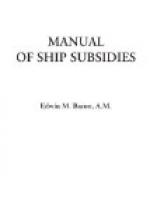The Atlantic made the initial voyage, steaming gallantly out of New York harbor on the twenty-seventh of April, a month before the contract time for the beginning of the service. The Pacific followed in June, the Baltic in November, the Arctic in December. They beat the Cunarders’ time on the average by a day. Their popularity was immediately established. Their passenger traffic rapidly increased. But the severe condition of the mail contract, with their quick sailings allowing only short stays in port, made it impossible for the company to secure a profitable share of the freight business without a heavy outlay for slower cargo boats. Within a few months after the start of the line the Cunard Company had cut freight rates from seven pounds ten shillings per ton to four pounds. So, while the Collins ships continued steadily to outsail the Cunarders and got the bulk of the passenger traffic, the Cunarders got most of the freighting. Moreover, the Collins ships were far more expensive to run. Indeed, the cost of the rapid service was enormous. Mr. Collins stated before a committee of Congress that to save a day or a day and a half in the run between New York and Liverpool cost the company nearly a million dollars annually.
Accordingly more subsidy was asked for. This was granted in 1852, the act being stimulated by England’s move late in 1851 in raising the Cunards’ subsidy to L173,340 ($843,000), for forty-four trips a year: about nineteen thousand dollars per voyage. The extra allowance lifted the Collins subsidy to $853,000 for twenty-six trips a year, thirty-three thousand dollars per voyage, a rate of upward of five dollars a mile.[GP]
The competition now became sharper. Still the Collins Line maintained its record sailings, and continued to beat the English. Then it was sharply checked by a grave disaster. On the twenty-fourth of September, 1854, the Arctic, when forty miles off Cape Race, rushing through a fog, was rammed by a French steamer, and sunk with three hundred and seven souls. This calamity had a depressing effect on the company’s affairs. Two years later, in 1856, Congress determined to reduce the subsidy, and notice of the discontinuance of the extra allowance of 1852 was ordered.[GQ] Only a few weeks after this action another disaster, even more appalling than the first one, befell the company. On September 23 the Pacific sailed from Liverpool for her homeward voyage with a full complement of passengers; passed to sea out of sight; and was never more heard of. She was replaced by the Adriatic, the fifth ship called for by the contract, which was launched the year before, the largest, finest, swiftest, and most luxurious then afloat; and the company struggled on against accumulating odds.
At length, in 1858, Congress abandoned the subsidy system and returned to the method of payment for foreign mail-carriage according to the actual service rendered, with a proviso, however, favoring American ships, such to receive the inland-postage plus the sea postage, while foreign ships were to have the sea postage only.[GR]




